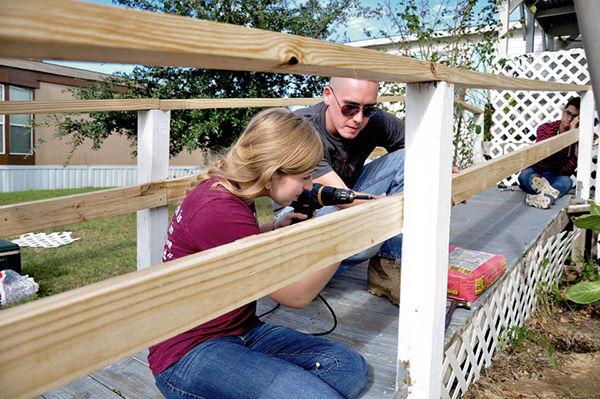A portion of the 12,000 engineering students at Texas A&M hope to take their technical skills out of the classroom and into the community with a new philanthropic organization.
Engineers Serving the Community is an offshoot of Texas A&M’s Engineers Without Borders. Both organizations aim to serve communities through unique engineering solutions, and ESC grew out of EWB as members sought to localize their international service approach.
Tyler Buffington, mechanical engineering junior and ESC’s first president, said the basic ideals from EWB have remained intact despite the change in focus that founding ESC has brought.
“Our mission is to use our engineering skills to improve the local community and improve campus in ways as well,” Buffington said. “We want to come up with ideas and innovations that make campus more sustainable, safer or better in some way.”
Since becoming an independent organization, ESC has tackled challenges on campus and in the community and has built a playground at a local church. The site was designed by student members of the ESC and is used by local children on an almost daily basis.
While the project has experienced success with the children it aimed to serve, Buffington said ESC members have future ideas to make it more interactive and educational.
“We’ve had the idea to add musical instruments to that structure with the hopes of getting very young children interested in music,” Buffington said. “Its been kind of a project to find what type of material we can tune to various frequencies and color code them and display songs in terms of color.”
ESC’s scope includes Texas A&M’s campus as well as the local community. George Gillette, civil engineering junior and ESC vice president of projects, said one issue ESC hopes to address is the blind corner that bikers and pedestrians face when trying to enter or exit the pedestrian tunnel under Welborn Road near Kyle Field and West Campus Garage.
“The ESC is working to design a system that would allow bikers coming from both directions to see people that are incorrectly in their lane,” Gillette said. “The design would allow people in the bike lane coming down to see those [around the corner] and prevent collisions.”
Gillette said plans are also in the works to develop an app that would allow students to report issues, such as sprinkler heads spraying onto sidewalks instead of grass, directly to those in charge of fixing them. This would speed up the process for repairs and help campus authorities know where the problems are.
The ESC may soon make a mark on Texas A&M’s engineering expansion — members are working with engineering administrators and architects to design a “green roof” for the new Engineering Innovation Center that the Zachry building will be renovated into.
Essentially, the green roof will be an alternative to a conventional roof that consists of vegetation instead of conventional structures. The surface serves to absorb rainwater, and decrease the carbon footprint of the building and university as a whole.
“We’ve discovered that these roofs, when implemented, increase building efficiency,” Buffington said. “It’s a project that’s been around for quite some time now. We did some research many schools and buildings across the United States that have implemented this design and had success with it.”
The green roof project has received a spot in the architect’s final plans for the new engineering complex, but lacks the funding it needs. The ESC is working closely with the Aggie Green Fund in a fundraising effort to allow for the plans to be implemented in the final design. Tell Butler, manager of engineering facilities at Texas A&M, said an official announcement of the plans should come sometime in January.
Engineers take skills beyond the classroom
December 7, 2014

PROVIDED
Computer engineering sophomore Alyssa Valdez and Blinn Team engineering sophomore Cole Frazier build a wheelchair ramp for a woman’s home in Bryan-College Station.
0
Donate to The Battalion
$2790
$5000
Contributed
Our Goal
Your donation will support the student journalists of Texas A&M University - College Station. Your contribution will allow us to purchase equipment and cover our annual website hosting costs, in addition to paying freelance staffers for their work, travel costs for coverage and more!
More to Discover








